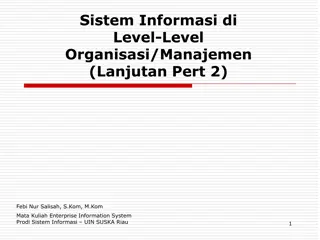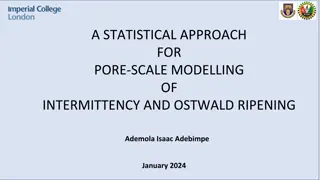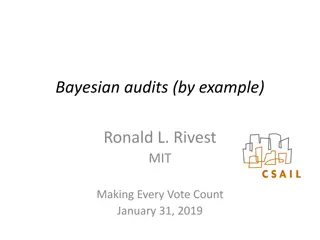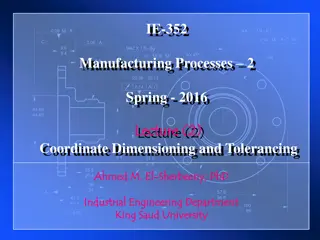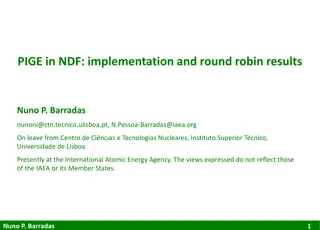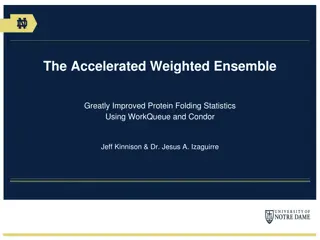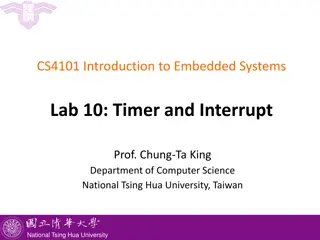Simulating Basic PNR and PA Systems: A Practical Approach
Explore how to effectively simulate basic Polarized Neutron Reflectometry (PNR) and Polarization Analysis (PA) systems to enhance proposal submissions and experiment success. Learn about the NIST PNR calculator, useful websites for calculations, and key elements in simulating data for analysis.
Download Presentation

Please find below an Image/Link to download the presentation.
The content on the website is provided AS IS for your information and personal use only. It may not be sold, licensed, or shared on other websites without obtaining consent from the author.If you encounter any issues during the download, it is possible that the publisher has removed the file from their server.
You are allowed to download the files provided on this website for personal or commercial use, subject to the condition that they are used lawfully. All files are the property of their respective owners.
The content on the website is provided AS IS for your information and personal use only. It may not be sold, licensed, or shared on other websites without obtaining consent from the author.
E N D
Presentation Transcript
Practical 3 What can PNR tell you how to simulate basic PNR and PA systems? Andrew Caruana, Christy Kinane ISIS Brian Maranville and Alex Grutter NCNR, NIST andrew.caruana@stfc.ac.uk, christy.kinane@stfc.ac.uk
Outline: Introduction Why bother? What's the point in simulating things at all when you can just fit actual data? Useful websites for calculating numbers. Introduction to the NIST PNR calculator. Question 1: How thin is thin, what s the smallest Ni dead-layer measurable with PNR? Question 2: How low can you go? What is the lowest Fe angle measurable with PA?
Introduction: Why bother? To get beamtime you have to submit a proposal? If the proposal is nonsensical then you will not get given beamtime. This is a big reason proposals are rejected! One of the best methods of showing a Facilities Access Panel (FAP) that your experiment has a chance of working is to show simulated data that demonstrates what you think will happen!
Introduction: NIST PNR calculator. The NIST PNR reflectivity calculator can be found at the following URL: https://pages.nist.gov/reflectometry-calculators/ You can of course simulate things in the fitting package of your choice but this online resource is very quick and easy to get going with. The other handy thing is it serves as a basic script generator for full Refl1D fits. It can be a good starting point for analysis. So save out your simulations and use them as a starting point for your analysis.
Useful Websites: If you need to calculate SLD s these websites are a great help: NIST SLD calculator: http://www.ncnr.nist.gov/resources/activation/ (Neutron and x-ray scattering lengths) NIST Table of scattering lengths and Cross sections: http://www.ncnr.nist.gov/resources/n-lengths/ ISIS Biomolecular Scattering Length Density Calculator: http://psldc.isis.rl.ac.uk/Psldc/ For all your protein and peptide SLD needs. Also has a manual explaining how this is done! NIST Resources including SANS and NR calculators: http://www.ncnr.nist.gov/resources/ https://pages.nist.gov/reflectometry-calculators <= WE ARE USING THIS ONE IN THE PRACTICAL! WebElements: http://www.webelements.com/ (Probably one of the most useful website on the web in my opinion) X-ray interactions with Matter CXRO : http://henke.lbl.gov/optical_constants/ 5
Introduction: Basic Layout Data Loader options Simulated data plot options Script generator options Beamline parameters Simulated reflectivity plot window Layer model parameters table Add delete layers buttons Simulated nSLD, i-nSLD and mSLD plot window Model import and export options Substrate side of the plot Plot export options Zooming in and out of the plots is linked to the mouse wheel and you can drag the position around by clicking in the plot and dragging in the direction you want
radians to degrees: Angles in the model table are in radians! So for conversion purposes 1 = (3.1416) radians = 180 deg e.g. 90 deg = 0.5 and 45 deg =0.25 But the AGUIDE field angle is given in degrees, this is a quirk of the webpage design. Don t worry about AGUIDE for now.
Question 1: Whats the smallest Ni dead-layer measurable with PNR? Q1: Given a maximum Q Range of 0.2 -1 what is the smallest magnetic dead layer than can be measured in a thick and thin sample? Sample structure => Si (substrate)/Ni (x) Where x = 1200 and x= 100 Where the Si substrates nSLD = 2.0723 x10-6 -2 , and the Ni has its full saturated moment of 0.6 B/atom. a) Calculate the nSLD of Ni Calculate the mSLD of Ni Simulate a 1200A Ni sample and compare dead-layers of various thicknesses? Simulate a 100A Ni layer and compare dead-layers of various thicknesses? Any ideas of what you could do to help boast the signal in the thin case? b) c) d) e)
How to Calculate a Magnetic Scattering Length Density (mSLD) How do we calculate the SLD? Easiest method: go to www.ncnr.nist.gov/resources/sldcalc.html www.ncnr.nist.gov/resources/sldcalc.html By hand: first calculate the Nuclear scattering length density for saturated Ni - Density (?) of Ni is 8.908 gm.cm-3; Molecular weight (M) is 58.69 gm. mole-1 Number of molecules per 3= N is given by: NAvogadro=6.022x1023 ? ? ????????? ? = 10 24 ? = 10-24(8.908/58.6934)*NAvogadro= 0.0914 Ni atoms per 3 ? bNi=10.3 fm ??? = ?? = ? ? = ??????= ? ??? SLD= b/volume = N(bNi) = 0.0914*(10.3) *10-5 -2 (the *10-5converts fm to ) SLDNi= 9.41 x10-6 -2 Adapted from the example given in the Roger Pynn online lecture slides: https://neutrons.ornl.gov/sites/default/files/intro_to_neutron_scattering.pdf 9
How to Calculate a Magnetic Scattering Length Density (mSLD) The saturated total magnetic moment of Ni is 0.6 b/atom which is equivalent to approximately 508 emu/cm3as would be measured from a magnetometer. The magnetic component of the SLD is given by: ? ? ????= ?????= ? ????= ?? ? ? The units of the magnetic scattering length, bm, are . This is the magnetic equivalent to the nuclear scattering length b here denoted bN. The magnetic moment per formula unit, , is in units of Bohr magnetons B - In this case the constant is C= 2.645 x 10-5 B-1 More usefully we normally measure the magnetisation M in a magnetometer and convert it to magnetic moment m by dividing it by the sample volume. - If m is in units of Tesla, then C = 2.645x10-5/4 -2T-1 - If m is in units of emu/cm3, then C = 2.853 x 10-9 -2cm3emu-1 This is taken from Application of polarized neutron reflectometry to studies of artificially structured magnetic materials by M. R. Fitzsimmons and C. F. Majkzak 10
How to Calculate a Magnetic Scattering Length Density (mSLD) SLDm= CNi i= 2.645 x 10-5 x 0.0914 x 0.6 = 1.451x 10-6 -2 The following from what we know about the SLD s: SLDNi= SLDNi (Nuclear) SLDNi (Magnetic) SLDNi+= (9.41+1.451) x 10-6 -2 = 10.861 x 10-6 -2 SLDNi-= (9.41-1.451) x 10-6 -2 = 7.959 x 10-6 -2 This results in two very independent reflectivity curves each with there own critical edge. This is what is measured by the Up and Down spin state reflectivity curves. 11
Question 2: What is the lowest angle for an Fe sample? Q2: What is the lowest angle that can be measured for a uniformly magnetised and fully saturated Fe sample if the system scattering has a background of 1 x 10-4. Sample structure => Si (substrate)/Fe (x) Where x = 600 Where the Si substrates nSLD = 2.0723 x10-6 -2 , and the Fe has its full saturated moment of 2.2 B/atom. a) Calculate the nSLD of Fe Calculate the mSLD of Fe Simulate a 600A layer of Fe and find the smallest angle you can measure Is there anything you can do to maximise the signal? (This may not be possible on a beamline) b) c) d)
Useful books: These are actually helpful when doing experiments! Free on web http://xdb.lbl.gov/ Deals with all stats needed for dealing with SANS/NR data. Deals with all theory that s is needed for doing scattering experiments. Deals with a lot of basic optics theory. Excellent for x-ray magnetic scattering. These are the books I learned from but there are many out there. Thank you for listening 13
Answers for Fe Fe nSLD = 8.0241 x 10-6 -2 Fe mSLD = 4.942 x 10-6 -2
How to Calculate a Nuclear Scattering Length Density (nSLD) How do we calculate the SLD? Easiest method: go to www.ncnr.nist.gov/resources/sldcalc.html www.ncnr.nist.gov/resources/sldcalc.html By hand: let us calculate the scattering length density for quartz SiO2 Density (?) of SiO2is 2.66 gm.cm-3; Molecular weight (M) is 60.08 gm. mole-1 Number of molecules per 3= N is given by: NAvogadro=6.022x1023 ? ? ????????? ? = 10 24 ? = 10-24(2.66/60.08)*NAvogadro= 0.0267 molecules per 3 ? ??? = ?? = ? ? = ??????= ? ???+ 2?? SLD= b/volume = N(bSi+ 2bO) = 0.0267(4.15 + 11.6) 10-5 -2 = 4.21 x10-6 -2 Adapted from the example given in the Roger Pynn online lecture slides: https://neutrons.ornl.gov/sites/default/files/intro_to_neutron_scattering.pdf 16



